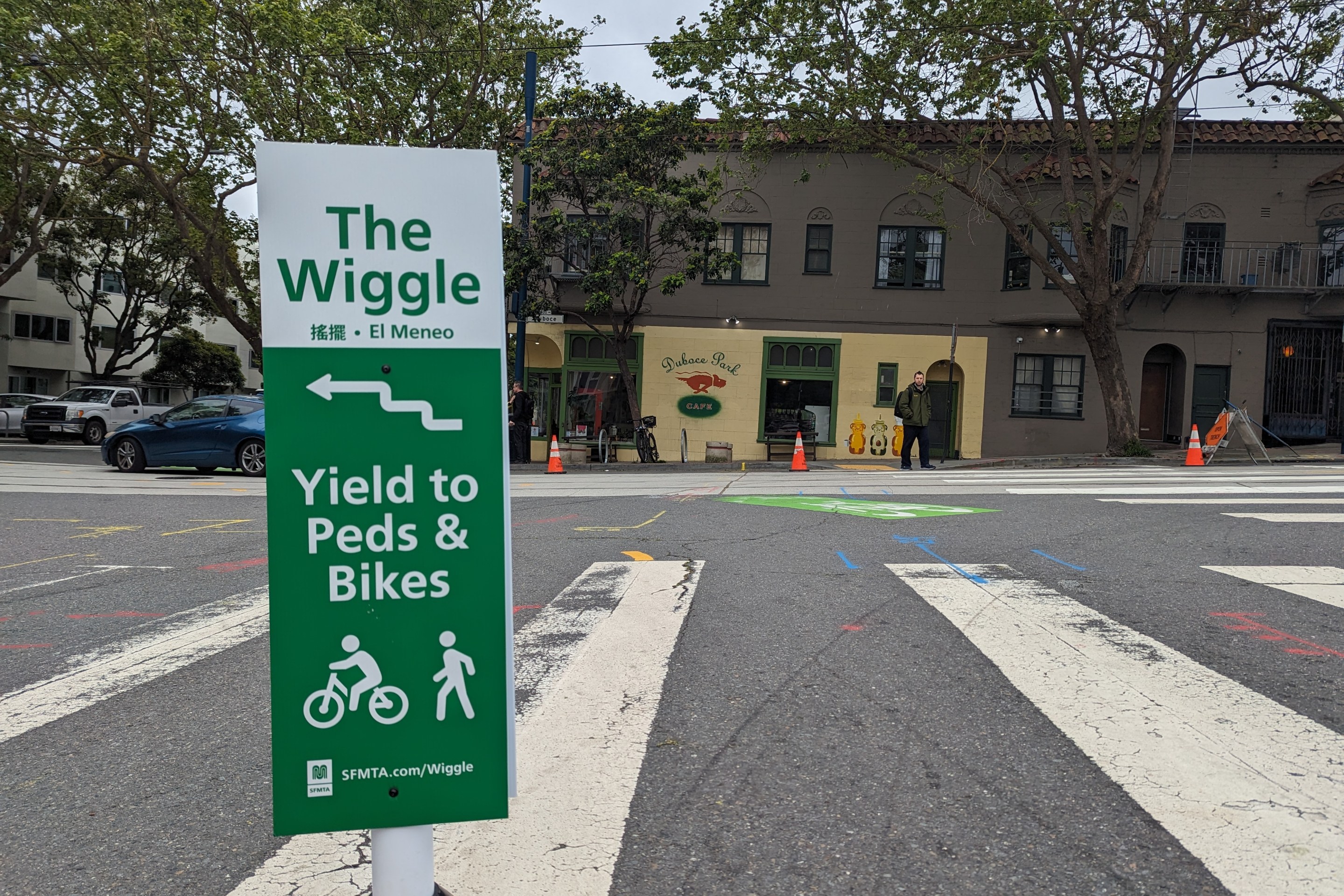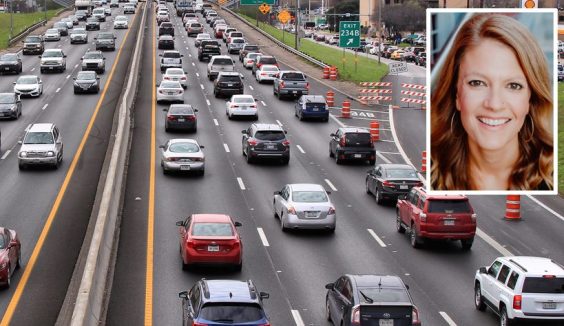Back to Civilization
10:07 AM PST on November 30, 2009
 A wet late afternoon on Norrebrogade in Copenhagen... bikes fill the lanes on either side of the street and a bus is in the near background. Not many cars!...
A wet late afternoon on Norrebrogade in Copenhagen... bikes fill the lanes on either side of the street and a bus is in the near background. Not many cars!...Returning to Copenhagen after some years away is always a pleasant shock. Few cities in the world feel as properly scaled as this lovely old Danish capital. My mother was born and raised here, so I've been visiting off and on over the years. No doubt my own visions of what San Francisco could be, in terms of a bicycling city, have always been shaped by my experiences here in Copenhagen.
The city is not a sprawling urban environment of single-family homes.
Most buildings are five stories and the vast majority of the city's
residents live in apartments. The density feels cozy rather than
crowded, though. The streets are full of pedestrians, and after several
decades of building a citywide system of dedicated side paths (few
streets don't feature a pedestrian sidewalk, a curb down to a wide bike
path able to handle two and three abreast, then another curb down to
the street) Copenhageners are famous for being big bicyclists (20-40%
of daily trips in the city are on bike, whether one is 8 or 88 years
old!). At every intersection bicycles pile up in their lane awaiting
their own phase of the signals, and often enjoy well-marked blue
pavement as they cross the street. As a recently arrived guest, it
takes a bit of adjustment to realize that you cannot blithely step off
the sidewalk because there are usually bicycles approaching at a
good clip.
 Typical of the many church spires which are the dominant characteristic of the human-scaled skyline of Copenhagen.
Typical of the many church spires which are the dominant characteristic of the human-scaled skyline of Copenhagen. Near the city's main pedestrian-only shopping street.
Near the city's main pedestrian-only shopping street. The streets in the center are not all closed to cars but even where they're not, the car is a subordinated transit form.
The streets in the center are not all closed to cars but even where they're not, the car is a subordinated transit form.Of course, there are cars here too, and some of the avenues are crowded with vehicles, especially at rush hour. But the trains and buses are fantastic, and the bicycle facilities are probably the best in the world. The Danes have taken great care of their beautiful city and have disallowed high rises in most areas. A few glass towers were built on the periphery (including an office tower for Carlsberg beer, next to its now discontinued brewery, an architectural treasure in its own right), but the skyline of Copenhagen still features centuries-old church towers as the prominent landmarks. The oldest observatory in Europe was built in the 1200s in the "round tower" and is open to tourists to climb its spiral ramps up to a good observation deck, more or less at the same height as the spires that dot the city's skyline. Looking down into the historic city center the streets are mostly full of pedestrians rather than cars, though many of the avenues are not closed to automobile traffic.
 Notice the pedestrian-filled streets beneath me, standing at the top of the Round Tower.
Notice the pedestrian-filled streets beneath me, standing at the top of the Round Tower. It's such a strange pleasure to suddenly be on streets where cars crawl at 5 mph and pedestrians and cyclists have full use of the street.
It's such a strange pleasure to suddenly be on streets where cars crawl at 5 mph and pedestrians and cyclists have full use of the street. Bike shops abound in this city, and though most are work-a-day kinds of places, here's a fancy hand-made bicycle boutique we happened upon.
Bike shops abound in this city, and though most are work-a-day kinds of places, here's a fancy hand-made bicycle boutique we happened upon.At Christiania, an old military base squatted in the early 1970s and still something of a free zone after all these years (though much less so than it once was), a freight bike was designed that takes its name from the community. Here is a a gallery of freight bikes, all commonly used by parents taking their kids to school, or even by the Danish post office to deliver the mail. They can be seen everywhere, as likely to be ridden by stylish women as blue-collar workers or commuting dads.
 Nothing even slightly unusual about a sight like this in Copenhagen.
Nothing even slightly unusual about a sight like this in Copenhagen. Freight bikes, or kid carriers as they are mostly used, are parked everywhere!
Freight bikes, or kid carriers as they are mostly used, are parked everywhere! An old beater of a Christiania bike.
An old beater of a Christiania bike. A more recent model, suitable for kid transport in bad weather!
A more recent model, suitable for kid transport in bad weather! They're not all wood anymore either!
They're not all wood anymore either! All successful markets attract competitors... this fibreglass model has extra wheels under its carriage for easy separation and pedestrian use.
All successful markets attract competitors... this fibreglass model has extra wheels under its carriage for easy separation and pedestrian use. This "Nihola" brand was impressive.
This "Nihola" brand was impressive. Same bike from the front.
Same bike from the front.We had the pleasure of staying with an old friend of mine in her quaint neighborhood abutting the old Carlsberg brewery. As you can see, the streets are used quite differently than any similar small residential streets are in San Francisco, where car parking would be the dominant use. Here, picnic tables, fruit trees, and ubiquitous bike parking take precedence, though some car parking is also allowed. During the cheerful and warmer summer months, the street comes alive with families and neighbors...
 Jerichausgade, a charming residential street not far from the former Carlsberg Brewery.
Jerichausgade, a charming residential street not far from the former Carlsberg Brewery. Another view of the same street... notice how little is dedicated to cars and parking compared to other uses.
Another view of the same street... notice how little is dedicated to cars and parking compared to other uses.Our imaginations are often stuck in the assumptions imposed by the car-centric 20th century. It's exciting and inspiring to come to an affluent modern city and see how different it can be, from transportation and parks to streetscapes and skylines. It's helpful to remember, too, that the Danes are a lot like Americans in many respects, but have managed to avoid the degradation of civic life we tend to take for granted. Here the cyclists are generally very polite, signaling their intentions on the road and obeying the traffic signals that are designed to facilitate bicycling transit. On the buses, people readily yield their seats to seniors and disabled, and no one lets a mother with a carriage struggle to enter or leave a vehicle. Sure, that still happens on BART or MUNI sometimes, but that kind of day-to-day sense of being in it together is far less tangible in our lives than it is here in Denmark. Even more dramatically, people here are all housed, whether they are junkies or alcoholics, schizophrenic or just incompetent. I suspect there is a direct connection between that level of social solidarity and the everyday courtesies that characterize Danish public life, two things we have much to learn from.
 A beautiful plaza in old Copenhagen.
A beautiful plaza in old Copenhagen.Stay in touch
Sign up for our free newsletter
More from Streetsblog San Francisco
Independent Safety Advocates Beef up the Wiggle
Signs and soft-hit posts installed by advocates make the Wiggle bike route calmer and safer for cyclists and pedestrians




